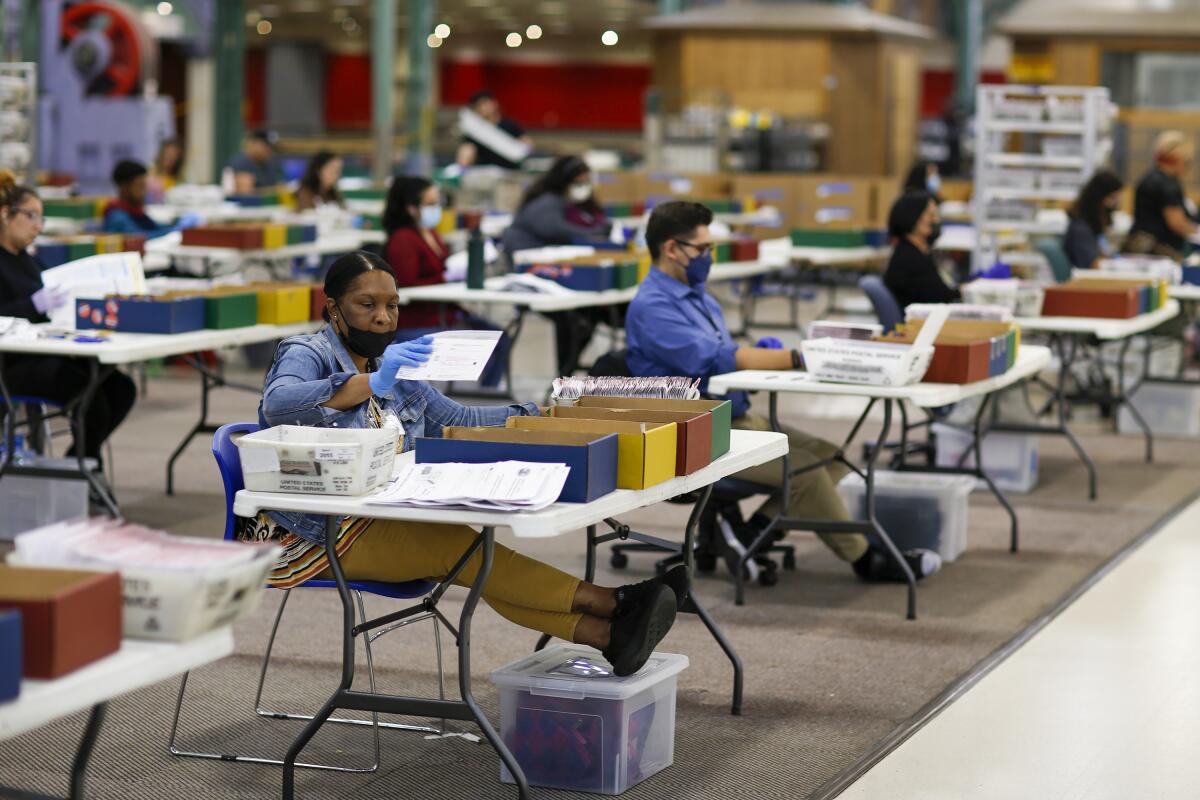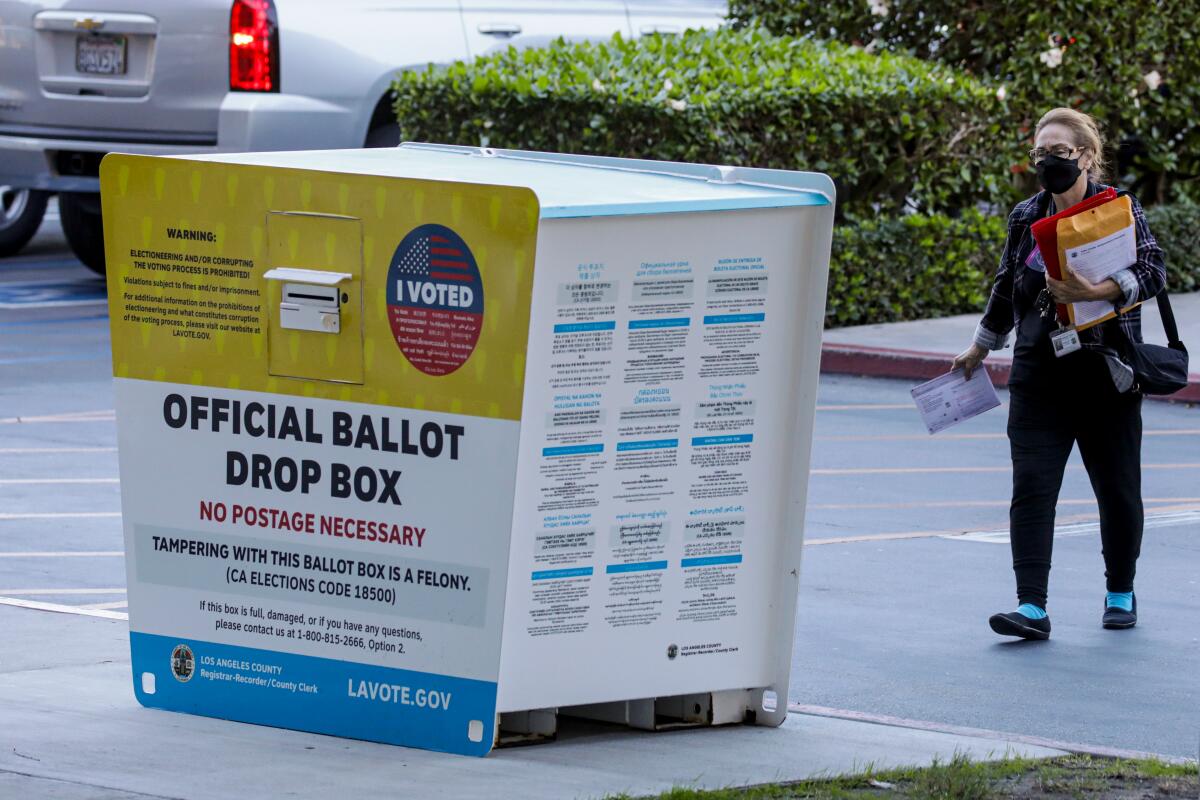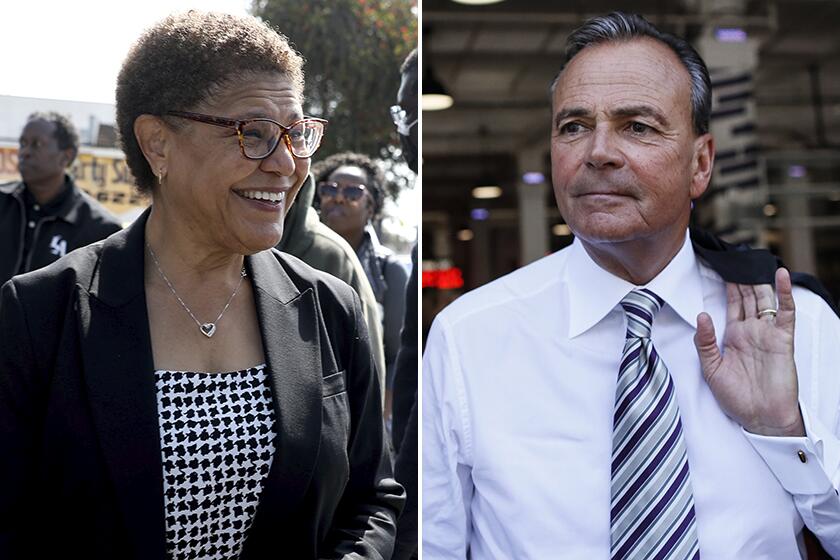Forget election night results. Answers might take days or weeks in some L.A. races

- Share via
Celebratory confetti blanketed the Grove on primary night, as developer Rick Caruso — then sporting a multipoint lead in the Los Angeles mayor’s race — declared his to be a “victory story.”
Across town in Highland Park, an exhausted Eunisses Hernandez had already headed home from her election night party at a local bar. Her opponent, incumbent Councilmember Gil Cedillo, was leading by more than 10 percentage points. Hernandez remained hopeful, though some supporters had begun mourning what they thought to be a loss.
But fortune can be a fickle mistress on election night.
On election night, Rick Caruso led Karen Bass in the L.A. mayoral primary and Chesa Boudin was losing recall by 20 points. Then came the mail ballots.
As Caruso backers danced to Hall & Oates and Hernandez supporters nursed craft beers, a steady stream of Sheriff’s Department vehicles continued to arrive at a county vote-tabulating facility in Downey, bearing bags of ballots. Scores of vote-by-mail ballots also had yet to be counted.
Those initial primary night returns represented only a small fraction of the total vote and weren’t indicative of broader trends.
Caruso ultimately finished 7 points behind Rep. Karen Bass. And Hernandez ousted Cedillo, making her one of several progressive council candidates to see their positioning reversed as successive waves of ballots were counted.
With the general election here, it’s likely that answers will remain unknown in a number of races Tuesday night. And what’s seen at 8:30 or 11 on election night may have little bearing on the final tallies.
The overwhelming shift to vote-by-mail ballots fundamentally altered how Californians participate in elections, with voting beginning weeks before “election day” and ballot tabulation extending for weeks afterward.
“We no longer have election night. We have election season,” said Mindy Romero, a political sociologist and director of the USC Center for Inclusive Democracy.
Final results may take days or weeks in certain high-profile races, including a handful of nail-biter congressional contests around the state and a number of competitive Democrat-on-Democrat races in Los Angeles city and county, such as the hotly contested L.A. mayor’s race.
Bass holds a narrow edge, but tens of millions of dollars in negative ads have powered Caruso into striking distance.
Still, the overwhelming registration advantage that Democrats hold in California dictates that most party-line statewide races are essentially noncompetitive, making some results easy to forecast before all ballots have been counted.
Gov. Gavin Newsom’s successful reelection bid seems already a foregone conclusion, and Sen. Alex Padilla — whose name appears twice on the ballot — is expected to handily defeat his opponent in both races.
Experts say most of the state propositions probably will also see clear winners or losers Tuesday night.
“If your race is within 10 points at the end of election night, it’s probably premature to call it a win,” said Michael Trujillo, a political consultant working on a number of local races this cycle. “If you’re up 20 [points], you’re probably safe.”
A 2021 law made the pandemic-inspired shift to universal vote by mail permanent — a move that has upended long-standing conventions about how long it “should” take to count votes.
In the June 2022 election, more than 90% of ballots cast statewide were vote-by-mail ballots and nearly 48 hours after polls closed, fewer than half of all ballots had been counted, according to an analysis by Kim Alexander, president of the nonpartisan California Voter Foundation.
Contrast those 2022 stats with the November 2004 election: Fewer than a third of statewide ballots were cast by mail, and more than 80% had been counted by 5 p.m. two days after the election, Alexander said.
Because mail ballots take significantly longer to process, a large crush of people voting by mail on or just before election day creates what Alexander described as ‘’’the pig-in-the-python phenomenon,’ where you just have this giant wad of ballots moving through the process.”
Ballots postmarked by election day are accepted for up to seven days in California. That means the total number of ballots cast won’t be certain until well into next week, making it difficult for experts to gauge how much results may shift in the days immediately following the election.
Experts and election officials stress that California’s comparatively slow vote counts are a feature of a working democratic system, not a bug.
After a two-decade push to provide more options and protections, it’s easier to vote in California than almost anywhere in the nation. But some of those elements create more work for election officials on the back end.
“The reason we take so long is we’re verifying all the ballots and making sure only valid ballots are being counted,” Alexander said. “So it’s a function of election security — the very election security people who criticize slow vote counts are demanding.”

Romero, the political sociologist, cautioned that results can — and probably will — shift in a number of races in the days to come.
When people hear one thing and then it seems to change, “they think something funny has happened or fishy has happened,” but such fluctuations are normal when votes are being counted, Romero said.
“Oftentimes, you’ll find that those later-counted ballots and even the votes on election day can be slightly different than the first tabulated ballots,” said Paul Mitchell, a Democratic strategist and political data expert.
Mitchell divided ballots into three distinct tranches: early vote-by-mail ballots, in-person voting and mail-in ballots received on or after election day, which the county will begin to tabulate on Wednesday.
Historically, the first tranche of ballots tended to be more conservative, with Republicans favoring mail-in ballots and turning them in early.
That dynamic shifted dramatically in 2020, as then-President Trump and others spread baseless allegations of widespread mail ballot fraud, pushing more Republicans to vote in person on election day.
In the June 2022 primary, Los Angeles County saw a substantial “blue shift” in postelection day tabulations, with Bass and other down-ballot progressives seeing results turn in their favor as day-of and late-arriving mail-in ballots were counted.
That late-breaking blue shift in June was unique to L.A. — in quite a few other parts of the state, results actually turned more conservative as successive waves of ballots were counted, Mitchell said.
Rick Caruso and Karen Bass are running for Los Angeles mayor. Here is your guide to the race.
He hypothesized that the mayoral primary drove L.A. voting behavior in June: Caruso was the clear choice in his political lane, whereas many progressive voters held on to their ballots as they decided among Bass and other left-leaning candidates such as Kevin de León or Gina Viola.
There’s no reason to think the general election results will follow the same pattern, Mitchell said. In fact, Mitchell speculated that later results could even favor Caruso.
The much-anticipated first wave of results released by the Los Angeles County registrar-recorder’s office Tuesday night will consist only of mail-in ballots received before election day, spokesperson Mike Sanchez said.
The second drop will add in results from early in-person ballots cast at county vote centers.
After that, there will be “continuous and reoccurring updates throughout the night” as election officials tabulate votes cast in person on election day, Sanchez said.
Another set of results will follow on Friday, with more results released every Tuesday and Friday in the weeks to come.
Final results in Los Angeles County are scheduled to be certified on Dec. 5, but experts say Angelenos should have a much better sense of where things stand in close local races by the middle to end of next week.
More to Read
Sign up for Essential California
The most important California stories and recommendations in your inbox every morning.
You may occasionally receive promotional content from the Los Angeles Times.

















